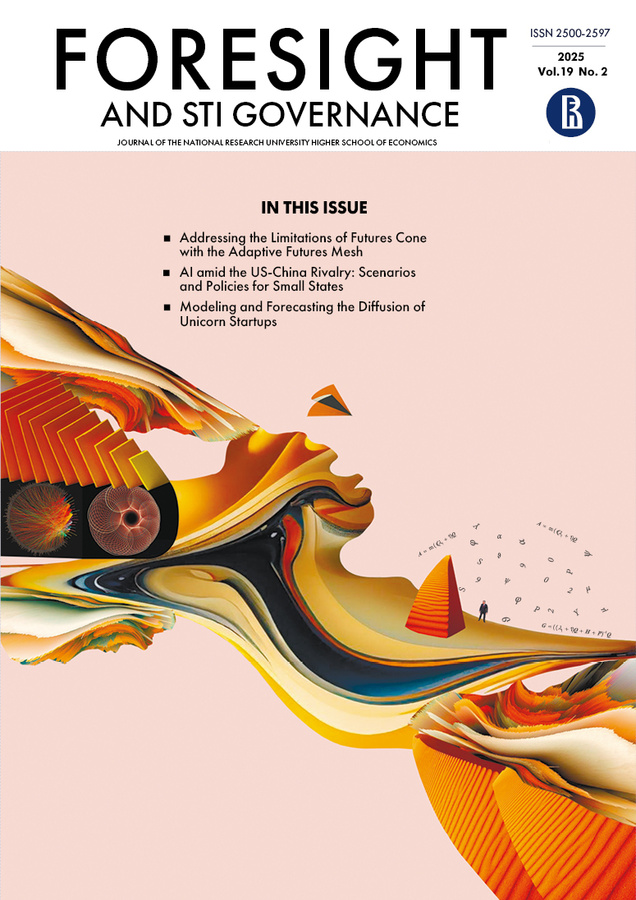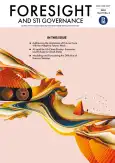Addressing the Limitations of the Futures Cone: Introducing the Adaptive Futures Mesh
- Authors: Hejazi A.1
-
Affiliations:
- Regent University
- Issue: Vol 19, No 2 (2025)
- Pages: 6-18
- Section: STRATEGIES
- URL: https://journal-vniispk.ru/1995-459X/article/view/307341
- DOI: https://doi.org/10.17323/fstig.2025.24819
- ID: 307341
Cite item
Abstract
This paper aims to address the limitations of traditional strategic foresight methodologies, specifically the Futures Cone (FC), by introducing and evaluating a novel framework called the Adaptive Futures Mesh (AFM). The study employs a conceptual analysis, drawing on systems thinking, complexity science, and participatory design principles to develop the AFM. The AFM is structured around key components including a dynamic mesh network, uncertainty gradients, adaptive feedback loops, and an emergence engine. The analysis finds that the AFM offers a more robust approach to navigating uncertainty by explicitly incorporating unknown unknowns (dark matter nodes). It visualizes cascading impacts, emphasizing human agency, and enables continuous adaptation through feedback loops. Research limitations include the lack of empirical validation and potential challenges in implementing the AFM across diverse contexts. However, the AFM offers significant practical implications for strategic planning. It enables organizations to move beyond prediction and cultivate futures-readiness. Socially, the AFM promotes more inclusive and equitable futures by democratizing foresight and empowering stakeholders to shape their own destinies. The originality and value of this paper lie in its articulation of a novel, adaptive framework that enhances strategic resilience in facing complexity and multiple crises.
About the authors
A. Hejazi
Regent University
Author for correspondence.
Email: alirhej@mail.regent.edu
References
- Anderson E.E. (1971) Modern physics and quantum mechanics, Philadelphia, PA: Saunders.
- Bendor R., Eriksson E., Pargman D. (2021) Looking backward to the future: On past-facing approaches to futuring. Futures, 125, 102666. https://doi.org/10.1016/j.futures.2020.102666
- Bohr N. (2011) Atomic theory and the description of nature: Four essays with an introductory survey, Cambridge: Cambridge University Press.
- Chapman G.B., Johnson E.J. (1994) The limits of anchoring. Journal of Behavioral Decision Making, 7(4), 223–242. https://doi.org/10.1002/bdm.3960070402
- Choudhury P.P. (2023) Formation of multiphase plasma in galactic haloes and an analogy to solar plasma. Frontiers in Astronomy and Space Sciences, 10, 1155865. https://doi.org/10.3389/fspas.2023.1155865
- Colosi D., Rovelli C. (2009) What is a particle? Classical and Quantum Gravity, 26(2), 025002. https://doi.org/10.1088/0264-9381/26/2/025002
- Copenhaver R. (2019) Philosophy of mind in the early modern and modern ages, New York: Routledge.
- Cristofaro M., Sousa M.J., Sánchez-García J.C., Larsson A. (eds.) (2021) Managerial and entrepreneurial decision making: Emerging issues, Basel: MDPI.
- Drees L., Liehr S., Batbuyan B., Marg O., Mehring M. (2022) In search of a nomadic pastoralism for the 21st century. A transdisciplinary development of future scenarios to foster a social-ecological transformation in Mongolia. Innovation: The European Journal of Social Science Research, 35(3), 481–505. https://doi.org/10.1080/13511610.2022.2100744
- Eliade M., Trask W.R., Smith J.Z. (2018) The myth of the eternal return: Cosmos and history (1st ed.), Princeton, NJ: Princeton University Press.
- Érdi P. (2008) Complexity explained, Cham: Springer.
- Estrada E. (2024) What is a complex system, after all? Foundations of Science, 29(4), 1143–1170. https://doi.org/10.1007/s10699-023-09917-w
- Futch M.J. (2008) Leibniz’s metaphysics of time and space, Cham: Springer.
- Gall T., Vallet F., Yannou B. (2022) How to visualise futures studies concepts: Revision of the futures cone. Futures, 143, 103024. https://doi.org/10.1016/j.futures.2022.103024
- Garrett K., Duda G. (2011) Dark Matter: A Primer. Advances in Astronomy, 2011, 968283. https://doi.org/10.1155/2011/968283
- Hancock T., Bezold C. (1994) Possible futures, preferable futures. Healthcare Forum Journal, 37(2), 23–29.
- Hawking S.W. (2011) A brief history of time: From the big bang to black holes, New York: Bantam.
- Hawking S.W., Penrose R. (2015) The nature of space and time (2nd ed.), Princeton, NJ: Princeton University Press. https://doi.org/10.1515/9781400834747
- Heisenberg W. (2013) Physical principles of the quantum theory (first published in 1930), New York: Dover Publications.
- Henchey N. (1977) The future of Quebec: Alternative scenarios. McGill Journal of Education, 12(1), 17–27.
- Hutton S. (1977) Some renaissance critiques of Aristotle’s theory of time. Annals of Science, 34(4), 345–363. https://doi.org/10.1080/00033797700200271
- Hvidtfeldt R. (2018) The structure of interdisciplinary science, Cham: Springer International Publishing. https://doi.org/10.1007/978-3-319-90872-4
- Hynes W., Lees M., Müller J.M. (eds.) (2020) Systemic thinking for policy making: The potential of systems analysis for addressing global policy challenges in the 21st century, Paris: OECD Publishing. https://doi.org/10.1787/879c4f7a-en
- Jaffe A. (2018) The illusion of time. Nature, 556(7701), 304–305. https://doi.org/10.1038/d41586-018-04558-7
- Kunseler E.-M., Tuinstra W., Vasileiadou E., Petersen A.C. (2015) The reflective futures practitioner: Balancing salience, credibility and legitimacy in generating foresight knowledge with stakeholders. Futures, 66, 1–12. https://doi.org/10.1016/j.futures.2014.10.006
- Maltarich M., Havrylyshyn A. (2023) The emergence engine: Socially mediated individual change. Academy of Management Proceedings, 2023(1), 13126. https://doi.org/10.5465/AMPROC.2023.84bp
- Mangnus A.C., Oomen J., Vervoort J.M., Hajer M.A. (2021) Futures literacy and the diversity of the future. Futures, 132, 102793. https://doi.org/10.1016/j.futures.2021.102793
- Mao H., Liu S. (2023) Research on the influence of innovative design based on the futures cone In: Proceedings of the 2022 2nd International Conference on Computer Technology and Media Convergence Design (CTMCD 2022) (eds. K. Subramanian, J. Ouyang, W. Wei.), New York: Atlantis Press International BV, vol. 99, pp. 403–410. https://doi.org/10.2991/978-94-6463-046-6_48
- Meadows D.H., Wright D. (2008) Thinking in systems: A primer, London: Chelsea Green Pub.
- Merleau-Ponty M. (2004) World of perception, New York: Routledge.
- Migone A., Howlett M. (2024) Multiple streams and plausibility cones: Using concepts from future studies to depict policy dynamics. International Journal of Public Administration, 48(5–6), 368–380. https://doi.org/10.1080/01900692.2024.2381769
- Miller R. (2018) Transforming the future: Anticipation in the 21st century, New York: Routledge.
- Muntwiler C. (2023) Cognitive biases and debiasing in strategic decision making (PhD thesis), St. Gallen: University of St. Gallen.
- Nickerson R.S. (1998) Confirmation bias: A ubiquitous phenomenon in many guises. Review of General Psychology, 2(2), 175–220. https://doi.org/10.1037/1089-2680.2.2.175
- Nozick R. (2001) Invariances: The structure of the objective world, Cambridge, MA: Belknap Press of Harvard University Press.
- Oosterling H.A.F., Tiemersma D. (eds.) (1996) Time and temporality in intercultural perspective, Leiden (Netherlands): Brill.
- Overton W.F. (1994) The arrow of time and the cycle of time: Concepts of change, cognition, and embodiment. Psychological Inquiry, 5(3), 215–237. https://doi.org/10.1207/s15327965pli0503_9
- Partelow S. (2018) A review of the social-ecological systems framework. Ecology and Society, 23(4), 26796887. JSTOR. https://www.jstor.org/stable/26796887
- Raczkowski K., Komorowski P. (eds.) (2025) International economic policy for the polycrisis, New York: Routledge. https://doi.org/10.4324/9781003487913
- Ramos V.J. (2019) Analyzing the role of cognitive biases in the decision making process, Hershey, PA: IGI Global.
- Rovelli C. (2007) Quantum gravity, Cambridge: Cambridge University Press.
- Schliesser E. (2013) Newton’s philosophy of time. In: A companion to the philosophy of time (eds. H. Dyke, A. Bardon), New York: Wiley, pp. 87–101. https://doi.org/10.1002/9781118522097.ch6
- Skov M., Nadal M. (eds.) (2023) The Routledge international handbook of neuroaesthetics, New York: Routledge.
- Stechert P. (2006) Informatics system comprehension: A learner-centred cognitive approach to networked thinking. Education and Information Technologies, 11(3–4), 305–318. https://doi.org/10.1007/s10639-006-9014-4
- Sterman J.D. (2000) Business dynamics: Systems thinking and modeling for a complex world (International student edition), New York: McGraw-Hill.
- Park E., Shin H. (2024) Contextualizing comedy techniques for speculative design: Unraveling futures cone from sketch comedy series, ‘2032/2033 futures’. Paper presented at the DRS2024 Conference, 23–28 June, Boston, USA. https://doi.org/10.21606/drs.2024.433
- Tabatabaei N. (2011) Detecting weak signals by internet-based environmental scanning (Master’s Thesis), Waterloo: University of Waterloo.
- Taleb N.N. (2010) The black swan: The impact of the highly improbable (2nd ed.), New York: Random House.
- Taleb N.N. (2012) Antifragile: Things That Gain From Disorder, New York: Random House.
- Van den Ende M.A., Wardekker A., Hegger D.L.T., Mees H.L.P., Vervoort J.M. (2022) Reflection: Applying participatory foresight methods in practice. In: Towards a climate-resilient future together (eds. M.A. van den Ende, A. Wardekker, D.L.T. Hegger, H.L.P. Mees, J.M. Vervoort), Cham: Springer International Publishing, pp. 61–70. https://doi.org/10.1007/978-3-031-07682-4_4
- Varela F.J., Depraz N. (2005) At the source of time: Valence and the constitutional dynamics of affect. Journal of Consciousness Studies, 12(8–10), 61–81.
- Voros J. (2003) A generic foresight process framework. Foresight, 5(3), 10–21. https://doi.org/10.1108/14636680310698379
- Walker B., Holling C.S., Carpenter S.R., Kinzig A.P. (2004) Resilience, adaptability and transformability in social-ecological systems. Ecology and Society, 9(2), 5. https://doi.org/10.5751/ES-00650-090205
- Winkler J., Moser R. (2016) Biases in future-oriented Delphi studies: A cognitive perspective. Technological Forecasting and Social Change, 105, 63–76. https://doi.org/10.1016/j.techfore.2016.01.021
- Zavala Rodríguez E.B., Marco Gómez J., Franch Gutiérrez J. (2019) Towards adaptative monitoring for self-adaptative systems, Barcelona: Universitat Politècnica de Catalunya.
Supplementary files









